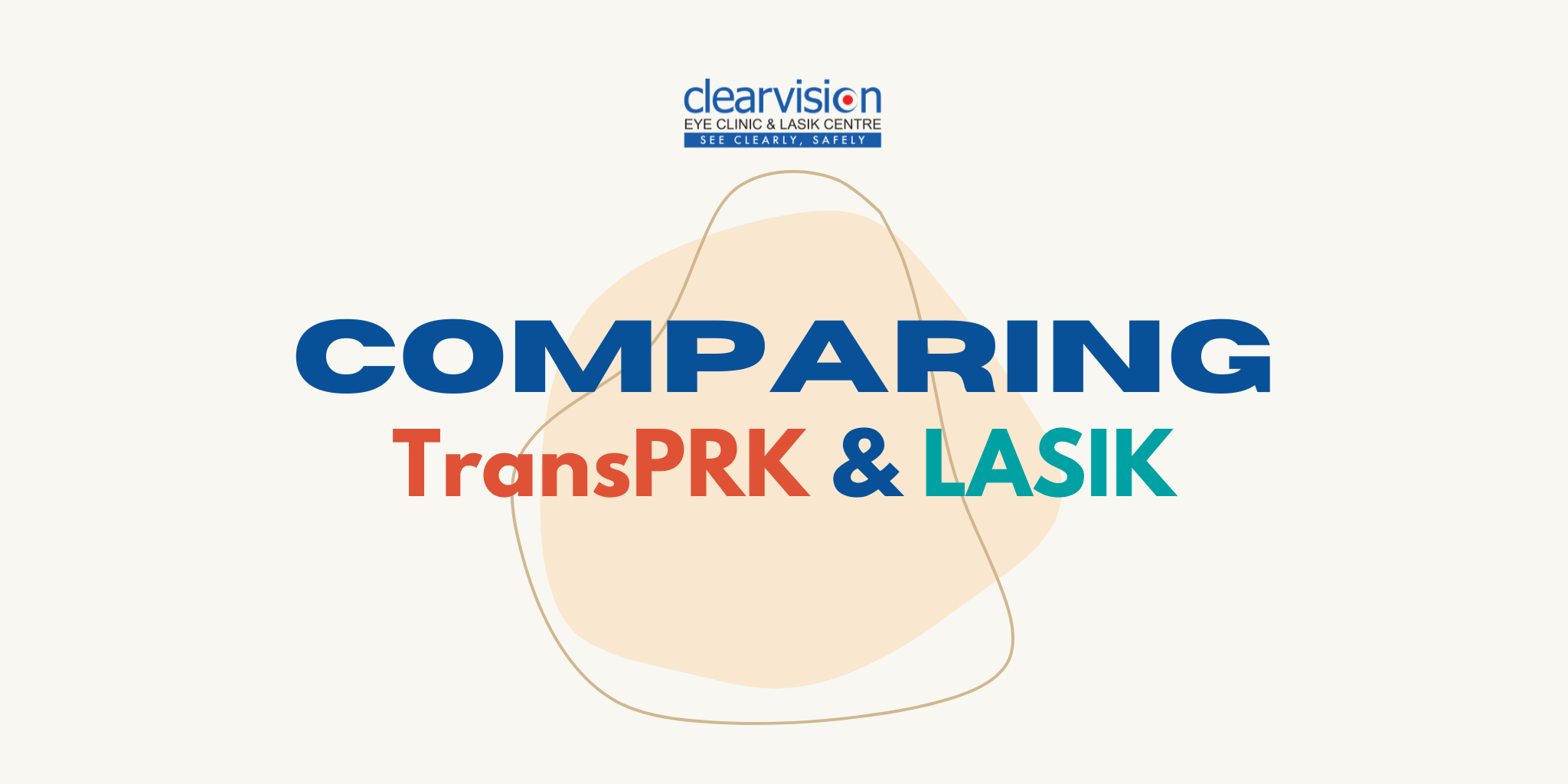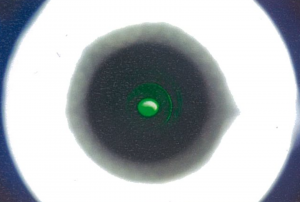Welcome to our detailed comparison between two popular methods of laser vision correction – TransPRK and LASIK. If you’re reading this, you’ve most probably started to get so sick and tired having to wear glasses and contact lenses, that you’ve decided it’s time to get your vision corrected. You’ve also probably gotten equally sick and tired of trying to decide which laser vision correction method to go for.
If the above assumptions are true, congratulations! You’ve not only taken a step in the right direction for your eyes, but you’ve also found what we hope will be the article that decides it for you.
So with a life free from glasses and contact lenses awaiting, let’s get on with comparing the minimally-invasive TransPRK procedure, with the most well-known laser vision correction method, LASIK.
Intro
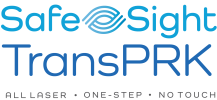
TransPRK (Transepithelial PhotoRefractive Keratectomy) is an Advanced Surface Ablation (ASA) procedure, meaning that there is no cutting to create a flap in order to allow the laser to access and reshape the cornea. Instead the laser simply ablates (surgically removes) the outermost layer of cells on the surface of the eye to reach the cornea.
What makes TransPRK different from other ASA procedures such as traditional PRK and Epi-LASIK, is that there is nothing actually physically touching your eye (besides the clamp to gently keep your eye open, of course) in order to remove the surface cells.
TransPRK was made possible with the creation of the Schwind Amaris 1050RS excimer (gas) laser in 2013, and is the much improved version of traditional PRK, which was the very first laser vision correction method introduced. PRK has been around since the early 1990s, and through the decades we have seen multiple iterations of ASA procedures, leading up to what we have today with TransPRK.

LASIK (Laser In-Situ Keratomileusis) is a flap-based laser vision correction surgery that can correct myopia, hyperopia and astigmatism.
Introduced in the early 1990s, this flap-based laser vision correction procedure has become one of the most popular and widely-known procedures for correcting refractive errors. It is so well known that the term “lasik” is used to refer to basically any type of laser vision correction.
With LASIK, a thin corneal tissue (flap), is created on the outer layer of the cornea. The flap is then folded back to expose the underlying corneal stroma tissue, which is then reshaped with an excimer laser to correct the refractive error.
At Clearvision, we perform Femto-LASIK, a bladeless form of the LASIK procedure. The flap is created with a fast and precise femtosecond laser, instead of a blade, thus providing a more comfortable and safe experience.
Suitability
TransPRK
- Hyperopia (difficulty seeing objects up close)
- Myopia (difficulty seeing objects at long distances)
- Presbyopia (difficulty focusing on objects up close, in older age a.k.a. lao hua yan)
- Astigmatism (distorted, blurry vision at any distance)
LASIK
- Hyperopia (difficulty seeing objects up close)
- Myopia (difficulty seeing objects at long distances)
- Presbyopia (difficulty focusing on objects up close, in older age a.k.a. lao hua yan)
- Astigmatism (distorted, blurry vision at any distance)
Treatable Conditions
TransPRK
Ideally, corneal thickness should be at least 485 microns thick.
Corneal cross-linking (CXL) is advisable as an adjunct treatment if your cornea is thin, or you have high astigmatism and/or high myopia (more than -8 diopters [800 degrees]). This procedure strengthens the cornea to prevent it from changing its shape in the future.
If you have myopia, your prescription must not be more than -10 diopters (1,000 degrees).
For hyperopia, not more than -4 diopters (400 degrees).
For astigmatism, not more than -5 dioptres (500 degrees).
LASIK
Ideally, corneal thickness should be at least 500 microns thick.
Corneal cross-linking (CXL) is advisable as an adjunct treatment if your cornea is thin, or you have high astigmatism and/or high myopia (more than -8 diopters [800 degrees]). This procedure strengthens the cornea to prevent it from changing its shape in the future.
If you have myopia, your prescription must not be more than -8 diopters (800 degrees).
For hyperopia, not more than -4 diopters (400 degrees).
For astigmatism, not more than -5 dioptres (500 degrees).
Procedure Steps
TransPRK
Length of surgery: about 5 minutes per eye
- Put on your surgical gown and other PPE
- Lie flat and get comfortable on the operating bed.
- A clamp is then used to keep your eyelids open
- Numbing eye drops are added so that your eye does not feel anything
- Your eye is lined up in the optimal position for the laser
- Stare straight at the dim green light
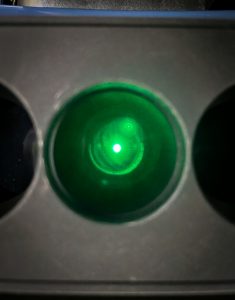
- The laser starts ablate the surface cells (you might smell a slight burning smell)
- The laser then starts to reshape the cornea
- Your vision has been corrected!
- A bandage contact lens is placed over the eye to allow the surface cells to safely heal (to be removed after 1 week by the doctor)
You will be able to see immediately after the TransPRK surgery. But as the surface cells heal in the next few days, your vision will get more blurry.
It should take 1 week for the cells to fully heal and for the blur to go away, after which you can resume your day to day activities and go back to work.
You will be given 1 week of medical leave.
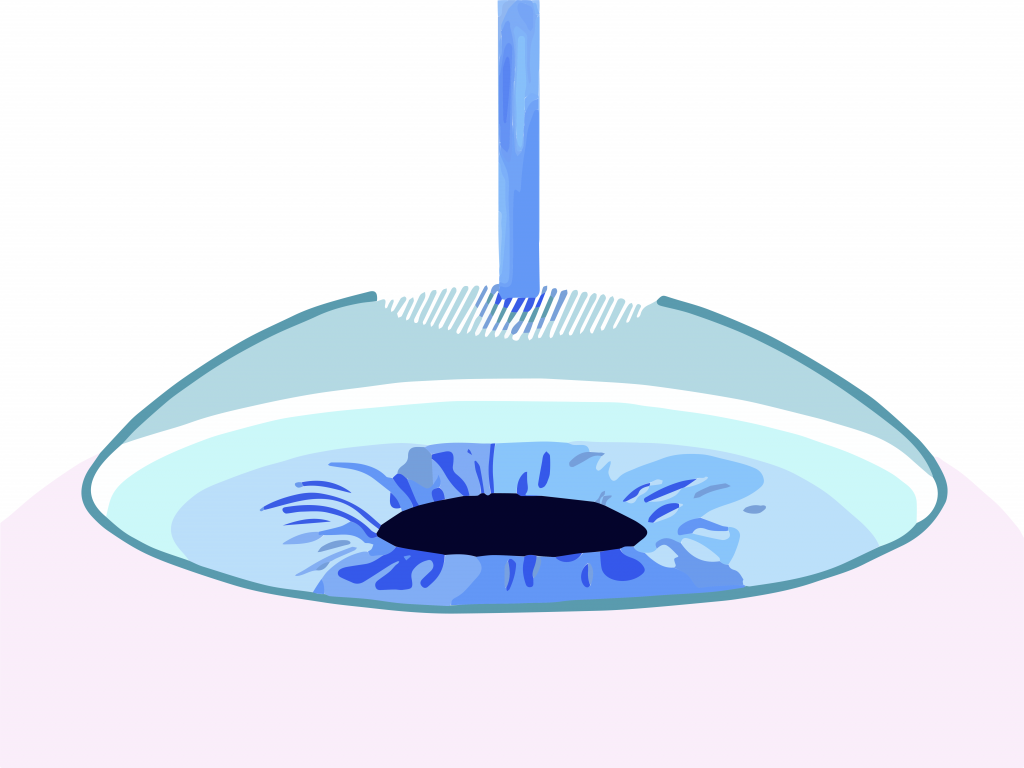
LASIK
Length of surgery: about 10 minutes per eye
- Put on your surgical gown and other PPE
- Lie flat and get comfortable on the operating bed.
- A clamp is then used to keep your eyelids open
- Numbing eye drops are added so that your eye does not feel anything
- Your eye is lined up with the contact glass, which uses low suction pressure keep your eye in position
- Stare straight at the dim green light.

- Femtosecond laser pulses are used to create a flap on the surface of the cornea
- The prepared flap is folded back, exposing the inner corneal tissue to be treated
- The laser removes the corneal tissue point by point within a few seconds, thereby correcting the visual defect
- Afterward, the flap is returned to its original position, protecting the eye much like a natural bandage
- Your vision has been corrected!
Your vision will be blurry immediately after the LASIK surgery. But your vision will clear up the next day, and continue to get less blurry in the next few days.
It will take just 2 – 3 days for your eye to heal and for the blur to go away, after which you can resume your day to day activities and go back to work.
You will be given 3 days of medical leave.
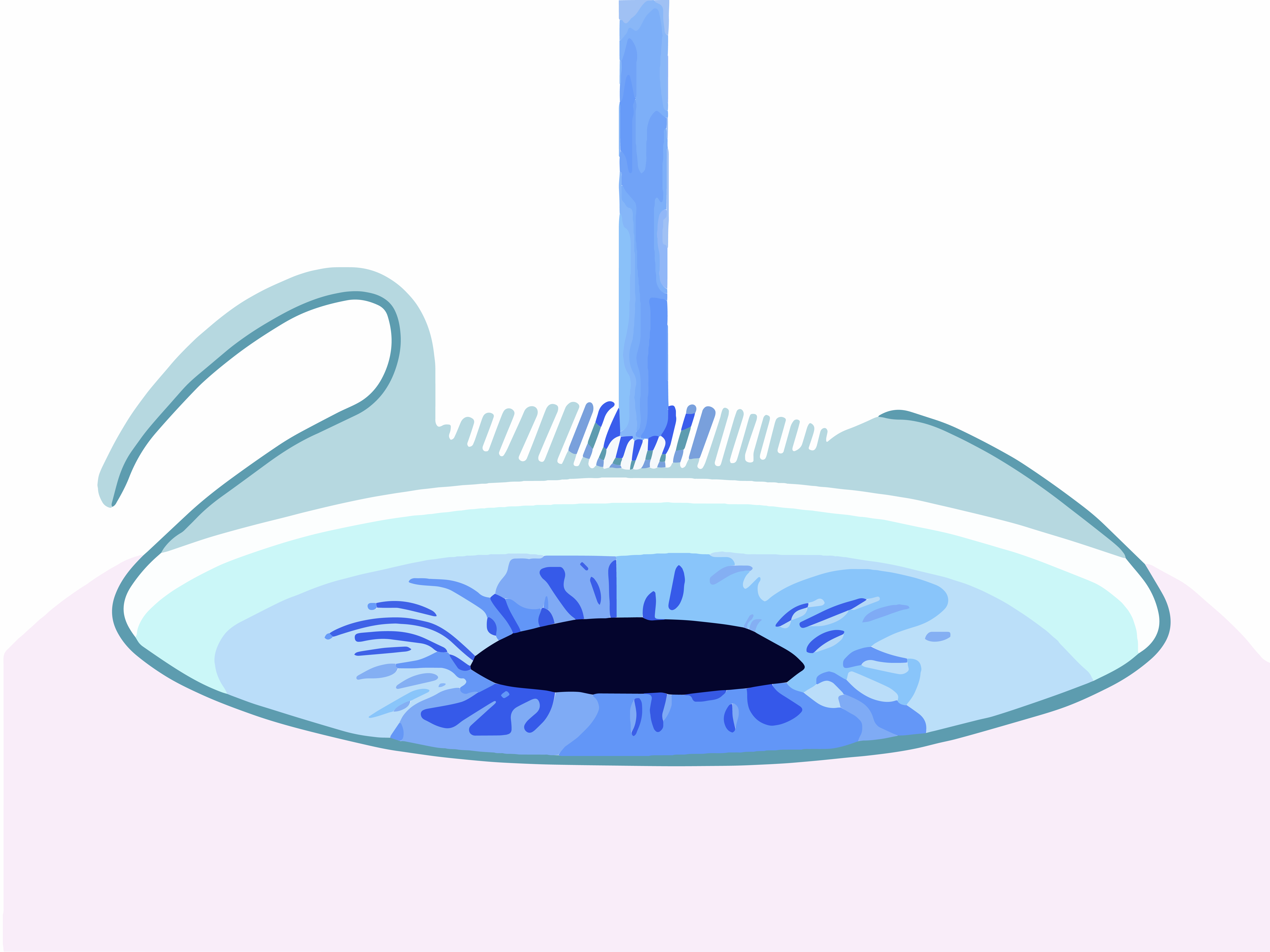
Recovery Process
TransPRK
Full visual recovery, where your vision has totally stabilised and your eyes are consistently seeing very clearly, takes between 1 – 3 months (patients with high myopia may take longer).
Patients are required to follow a strict routine of eye drops application.
Protective sunglasses must be worn whenever outdoors for 1 month, to prevent UV exposure which can be harmful to the healing process. (UV blocking sunglasses are provided to Clearvision patients).

LASIK
Full visual recovery, where your vision has totally stabilised and your eyes are consistently seeing very clearly, takes around 1 – 2 months (patients with high myopia may take longer)
Patients are required to follow a strict routine of eye drops application.
Protective sunglasses must be worn whenever outdoors for 1 month, to prevent UV exposure which can be harmful to the healing process. (UV blocking sunglasses are provided to Clearvision patients).
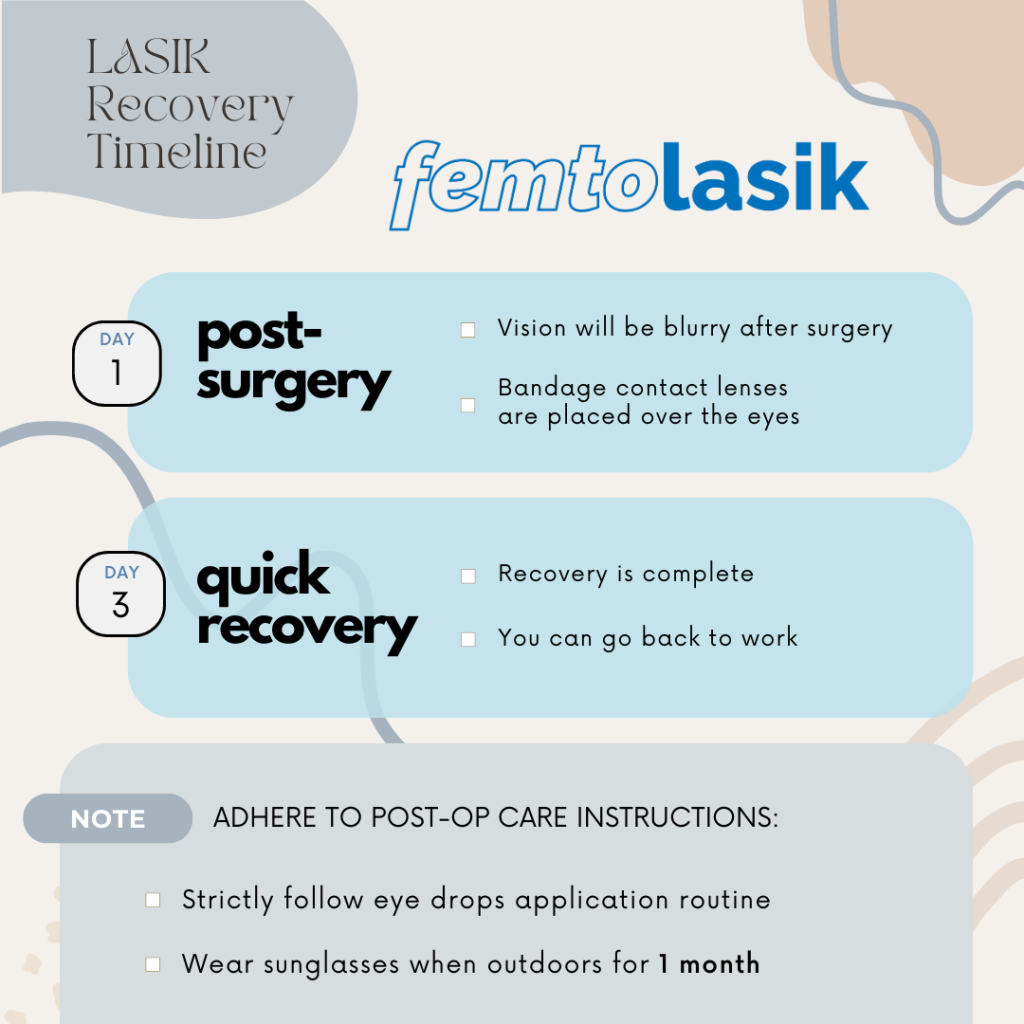
Post-Operative Follow Up Reviews
TransPRK
After surgery, you can expect to return to the clinic for follow-up reviews at these points during your recovery:
- 1 day / 2 days post-surgery (depending on what day of the week you had your surgery)
- 1 week post-surgery
- 2 weeks post-surgery
- 1 month post-surgery
- 2 months post-surgery
- At some point(s) between 3 – 6 months post-surgery (especially if you had high myopia)
More follow-ups may be required, subject to the individual’s healing progress.
LASIK
After surgery, you can expect to return to the clinic for follow-up reviews at these points during your recovery:
- 1 day post-surgery (depending on what day of the week you had your surgery)
- 1 week post-surgery
- 1 month post-surgery
- 2 months post-surgery
More follow-ups may be required, subject to the individual’s healing progress.
Resuming Regular Activities
TransPRK
Post-TransPRK, you will be allowed to resume these activities after a specific period of time:
Light sports: 5 days
Long sessions of reading books, screens and watching TV: 1 week
Driving: 1 week
Applying eye makeup : 1 week
Showering without having to make sure that no water enters the eyes: 1 week
Swimming and other water-related activities: 2 weeks
Contact sports: 2 weeks
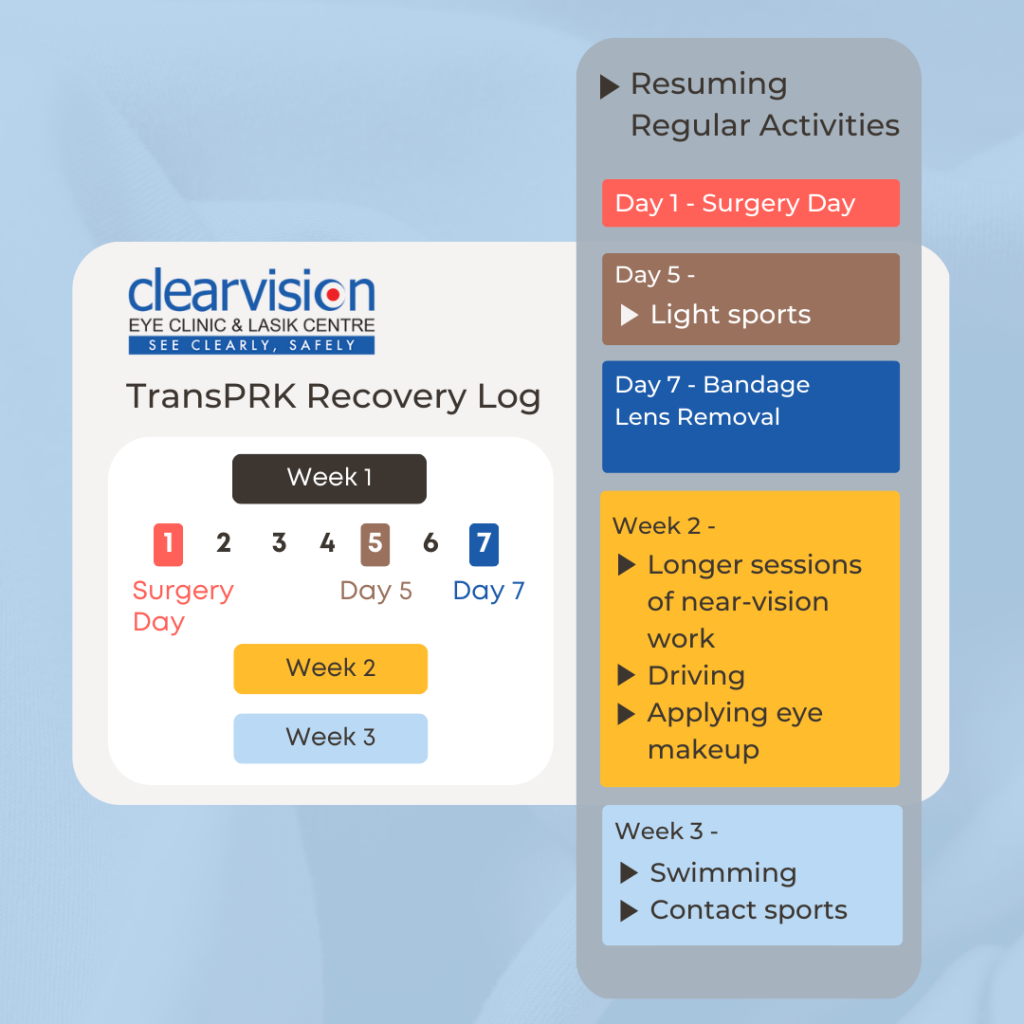
LASIK
Post-LASIK, you will be allowed to resume these activities after a specific period of time:
Long sessions of reading books, screens and watching TV: 1 day
Driving: 1 day
Light sports: 5 days
Applying eye makeup : 1 week
Showering without having to make sure that no water enters the eyes: 1 week
Swimming and other water-related activities: 1 month
Contact sports: Not advisable as the cornea flap may dislodge

Pros
TransPRK
- No flap-related complications
- Low risk of dry eyes
- Ability to participate in contact sports
- No surgical instruments touching the eye
- Wide range of suitability criteria (high myopia, thin corneas etc.)
- Length of surgery is short (5 mins per eye)
LASIK
- Little to no discomfort during recovery
- Quick recovery, with just 2 – 3 days of downtime
- Wide range of suitability criteria (high myopia, thin corneas etc.)
Cons
TransPRK
- Some discomfort early on during the healing process (mild itchiness or soreness on the surface of the eye)
- Slower recovery of surface cells, resulting in 1 week of downtime
- More follow up reviews required
LASIK
- Corneal flap creation
- 1-2% risk of flap complications (flap dislodgement, flap wrinkles, flap inflammations and flap interface issues)
- Risk of dry eyes
- Risk of night vision issues
- Impacts corneal stability
Price at Clearvision Singapore
TransPRK
S$4,188 for both eyes, inclusive of GST
LASIK
S$4,188 for both eyes, inclusive of GST
Prices comprise of:
- Surgery for both eyes
- Post-op reviews for three months
- Initial set of medications
- One pair of UV-protected sunglasses
A suitability evaluation is first required and will cost S$55 (inclusive of GST).
Conclusion
We hope that this comparison gives you a good idea of the advantages and disadvantages of both procedures. In short, TransPRK offers a minimally invasive, flap-less and blade-less procedure with no cutting of a corneal flap. However, visual recovery is slower. LASIK on the other hand provides a quick recovery, but because a corneal flap is cut, there is a greater risk of corneal flap complications and dry eyes. Therefore, TransPRK is a good option for those who are averse to dry eyes and flap-complications, and lead an active lifestyle.
Whichever procedure you choose, we can’t tell you enough how excited we are at the thought of your life with clear vision, where you will finally be able to see well while:
- Swimming or doing any water-related activities
- Taking a shower
- Relaxing in a spa / sauna
- Getting a haircut (no more surprises after you put your glasses back on)
- Getting trapped in the rain
- Trying to look at the clock on your bedroom wall in the morning
- Rushing to the restroom in the middle of the night
- Riding a high-speed roller coaster
- Exiting an air conditioned area (goodbye foggy glasses)
- Wearing a mask (goodbye again foggy glasses)
- In between naps on a long-haul flight (no more fumbling for your glasses)
And for contact lens wearers, not having to deal with all the expenses, inconveniences, infections, and dry eyes that come with it!
If you want to learn more about other laser vision correction methods, please visit our comparison table, or check out the comprehensive article comparing two of our flapless and bladeless procedures at Clearvision Singapore – TransPRK and SMILE.
Book Your Eye Evaluation
If you would like to book a suitability evaluation with us to determine if you are eligible for laser vision correction surgery,
📞 Call us at 6733 3316
📱 WhatsApp us at 8383 7989
✉️ Email us at doctor@clearvision.com.sg
🤳 Message us on Facebook
🤳 Message us on Instagram
The evaluation costs $55 and will take around 1 – 2 hours.
It will include a series of eye tests as well as a personal consultation with your lasik surgeon.
Suitability Evaluation Guide
Our suitability evaluations typically take place during these times, subject to availability –
| Mondays | 2:30 PM – 3:30 PM |
| Tuesdays | 9:00 AM 2:30 PM – 5:15 PM |
| Wednesdays | 9:00 AM |
| Thursdays | 2:30 PM – 3:30 PM |
| Fridays | 9:00 AM – 11:00 AM 2:30 PM – 5:15 PM |
Let us know which days and times work for you and we’ll do our best to accommodate!


